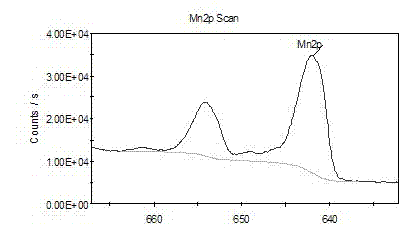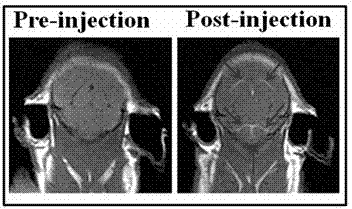Method for manufacturing KMnF<3> nuclear magnetic resonance imaging contrast agents
A technology for nuclear magnetic resonance imaging and contrast agent, which is applied in the fields of nuclear magnetic resonance/magnetic resonance imaging contrast agent, preparations for in vivo tests, pharmaceutical formulations, etc., and can solve the problems of low relaxation efficiency, unstable Mn, and difficult diagnosis, etc. Achieve high transverse relaxation efficiency, high biocompatibility, and good application prospects
- Summary
- Abstract
- Description
- Claims
- Application Information
AI Technical Summary
Problems solved by technology
Method used
Image
Examples
Embodiment 1
[0032] Embodiment 1: Weigh 0.3298gMnCl 2 . 4H 2 O, 0.4706gKF . 2H 2 O and 1.0686g of potassium oleate were dissolved in 16ml of absolute ethanol, stirred evenly, transferred to a polytetrafluoroethylene liner and sealed, placed in a stainless steel jacket, tightened and placed in an oven, heated to 160 degrees, and kept for 24 hours. After cooling to room temperature, the liner was taken out, and the product was washed with deionized water and then with absolute ethanol, and then centrifuged to obtain KMnF 3 Nanocrystalline.
Embodiment 2
[0033] Embodiment 2: as figure 1 , 2 , 3, 4, 5, 6, 7, and 8, the reaction product obtained in Example 1 was added to 16ml of absolute ethanol, and then 0.1gPEG-1500 was added for ultrasonic oscillation to disperse evenly and then transferred to a polytetrafluoroethylene inner container Sealed in the middle, placed in a stainless steel jacket, tightened and placed in an oven, heated to 180 degrees, kept warm for 2 hours, cooled to room temperature, then taken out the liner, washed three times with deionized water and then three times with absolute ethanol, and dried at 60 degrees 2 hours.
PUM
| Property | Measurement | Unit |
|---|---|---|
| Particle size | aaaaa | aaaaa |
| Size | aaaaa | aaaaa |
Abstract
Description
Claims
Application Information
 Login to View More
Login to View More - R&D
- Intellectual Property
- Life Sciences
- Materials
- Tech Scout
- Unparalleled Data Quality
- Higher Quality Content
- 60% Fewer Hallucinations
Browse by: Latest US Patents, China's latest patents, Technical Efficacy Thesaurus, Application Domain, Technology Topic, Popular Technical Reports.
© 2025 PatSnap. All rights reserved.Legal|Privacy policy|Modern Slavery Act Transparency Statement|Sitemap|About US| Contact US: help@patsnap.com



